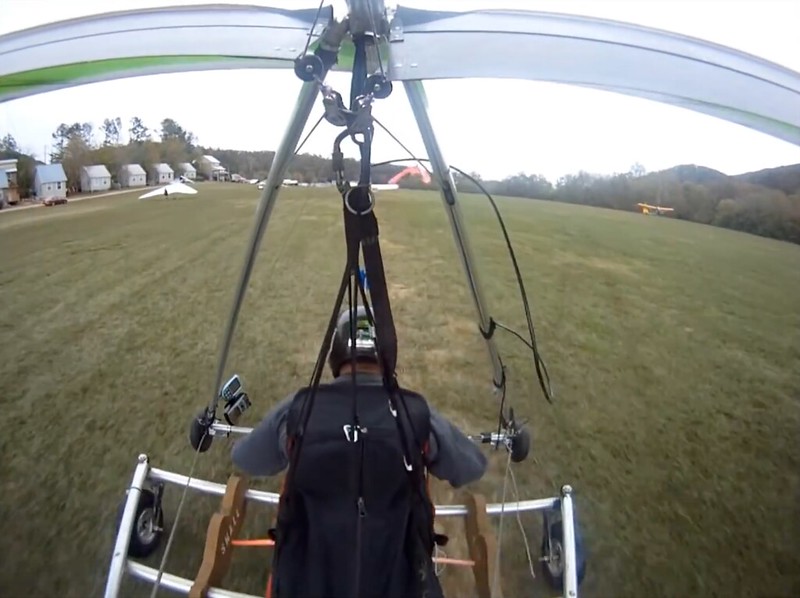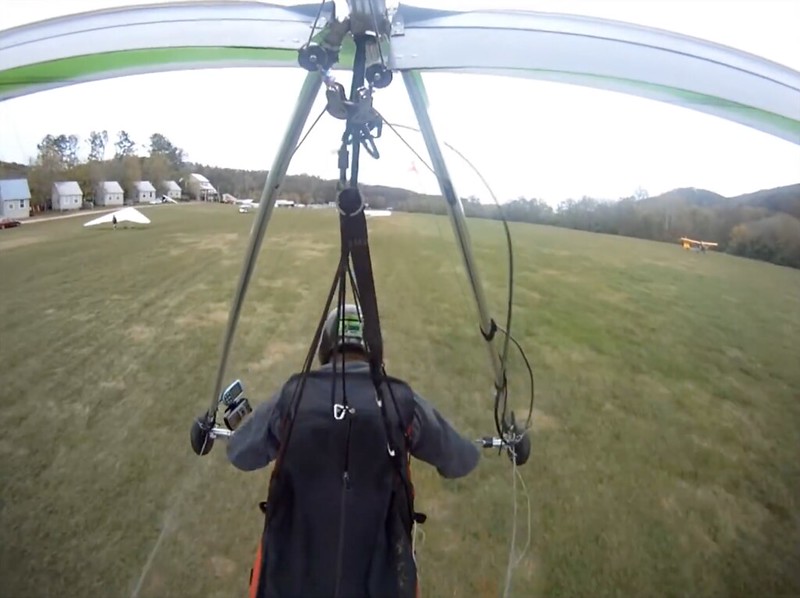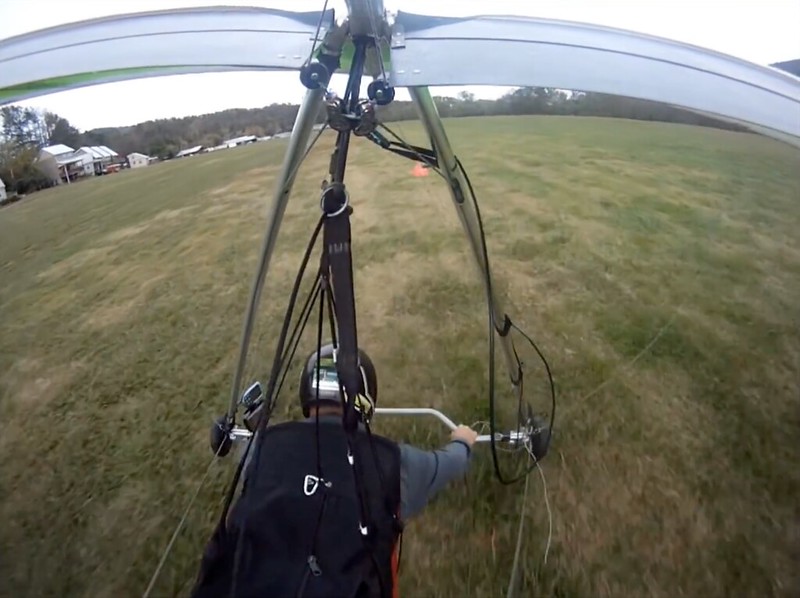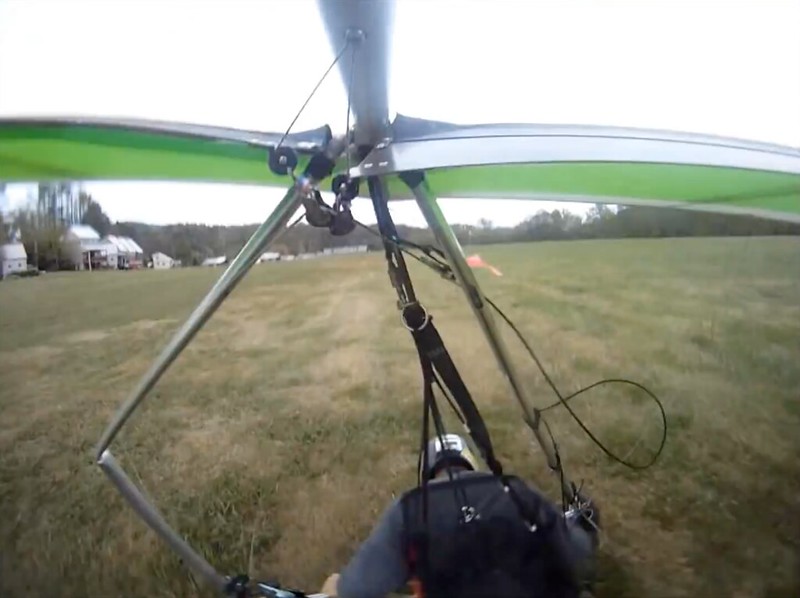Steve Kinsley - 2006/03/27
Squidlinks Emergency Release.
Squidlinks is a modified 3 ring where you hold the final loop, the release loop, in your teeth. The release loop is also routed through a grommet. Once safe altitude is reached, you slide the barrel/keeper over the grommet. This pinches the line so you don't have to hold on to the release loop with your teeth through the entire tow.
Figure 1. Basic Hook-up.
The release strap (red above) is attached to the shoulder tow point. The initial loop is shown going directly through the bridle without a weak link but it works fine with a weak link. To lock the release, slide the barrel down over the grommet (as shown above). When you are on the cart and hooked up to the tug, put the release loop in your mouth and slide the barrel back away from the grommet.
Figure 2. Ready to Tow
Note angle of release string. It should be a fairly sharp angle (near 90 degrees). This decreases the tow pressure. Also Note: Release loop shown going over chin guard for clarity but I generally run it under the chin guard. Putting it over pulls my helmet down.
Figure 3. Locking the release on tow
When you are 200 feet up or so grab barrel and shove it forward vigorously as far as it will go. You do not have to release the loop from your teeth first. It is actually very easy and quick. Practice it on the cart once or twice.
General Notes:
1. There is tow pressure. Not much when keel towing. More when shoulder towing. It is not horrible; it is not going to pull your teeth out or anything and it is only for 200 feet (or until whatever altitude you feel that you are out of danger). Yes, you can hold on even when the force is enough to pop the weak link.
2. Red strap material only: If you adjust the strap length, don't tie the release strap to the tow loop with an overhand knot. The strap material is too slick. Make a loop.
3. Yes, I agree that the stitching looks like it was done by a ten year old with ADD but it doesn't seem to matter.
4. This is a device intended to offer some advantage (significant advantage I believe) if the glider comes off the cart crooked and starts to kite. Every year, people are hurt or killed or have the crap scared out of them by this. It has never happened to me but I don't think I am immune. It reportedly happens really fast.
If you are lucky the weak link breaks before the glider reaches a non recoverable attitude. I think that most of these incidents are caused by improper (too high) AOA on the cart combined with windy (especially cross), and thermally conditions. Shoulder tow also complicates the situation.
If you are keel towing you can pull in on the cart and reduce the AOA (the keel pops out of the support). This is harder to do shoulder towing because you need to accelerate the cart and glider ahead of you which to some extent requires that you push out. Also, pulling in can get you pulled through the control frame. So check that AOA (tips parallel to the ground). And use the Squidlinks. And commit to getting off immediately if you are seriously crooked.
That's insanity.The initial loop is shown going directly through the bridle without a weak link but it works fine with a weak link.
This ain't rocket science. This was within the pay grade of even Dennis and Bill. This is what got Shane Smith extremely predictably killed. This is what's gonna give Davis a lot of the ammunition he needs to sink this thing.Towing Aloft - 1998/01
Safety Tip: Beware of threading a string release directly through a weak link or loop in the end of a small diameter rope. Do not thread a large diameter cord through a loop made with a much smaller diameter cord. Under tension, the smaller diameter cord can pinch the larger diameter material enough that is may fail to release. Soft rings made from half inch tubular webbing may work well for the string release to loop through to prevent pinching.
In the photo he's got his three-string mounted on his right shoulder engaging a stupid overlength bridle going through the tow ring and back to a 130 pound Greenspot Tjaden Link (which he undoubtedly picked up from the assholes at the Ridgely flight line) engaged by an idiot bent pin release on his left shoulder.
As shoddy as that configuration is - it will work.
If the right end of the bridle wraps it is a virtual certainty that the Tjaden Link will blow 'cause it's only good for a few pounds more than normal tow tension and it's gonna get a little jolt.
If the Tjaden Link doesn't blow the most you'll hafta pull the Bailey is 21 pounds.
If the Tjaden Link welds itself to the tow ring it doesn't matter. The more load you have on the three-string the harder it is to keep it from NOT blowing.
- If you have the trigger loop in your teeth you'll hafta fight to keep it from pulling free.
- Steve's locking mechanism isn't very good and won't hold much extra tension.
- Even if it doesn't allow the trigger loop to pull free, Steve's locking mechanism doesn't become harder to operate with increasing tension - easier if anything.
- In other words, Steve's three-string doesn't NEED a weak link - Steve's three-string IS a weak link.
Steve, you're a lot smarter than that.This decreases the tow pressure.
The trigger lines on these things NEED do be routed under the chin guard.Release loop shown going over chin guard for clarity but I generally run it under the chin guard.
That's kinda clueless. If you DO release the loop from your teeth first the tow is OVER. PERIOD. This is NOT an option.You do not have to release the loop from your teeth first.
By which he means that with his three-string is transmitting a significant enough portion of the towline tension to the trigger loop as to make things a bit uncomfortable. I told him it needed to be a four-string - especially when you're using a REAL weak link - and he eventually reached the same conclusion himself.There is tow pressure.
1.7 times as much.More when shoulder towing.
Yes, THE weak link. The standard aerotow weak link - in this particular case.Yes, you can hold on even when the force is enough to pop the weak link.
Yeah Steve. You'll recall my reaction to that Overhand Knot before you changed materials, could no longer get away with it, and gave Rooney ammunition for telling all his stupid ass kissing cult members about the horrors of...If you adjust the strap length, don't tie the release strap to the tow loop with an overhand knot.
I was showing Steve how to tie a Becket Bend shortly after that one....completely untested and very experimental gear which will likely fail in new and unforseen ways as it tries it's damndest to kill you.
Not until you start using real weak links and testing up to real loads anyway. Oh well, if it fails it's the weak link and you're off tow. Most of the time that's not a serious problem.Yes, I agree that the stitching looks like it was done by a ten year old with ADD but it doesn't seem to matter.
You've never needed a parachute either. But both of us personally know more people who needed one of these than needed parachutes. But EVERYBODY we know flies with a parachute and virtually NO ONE we know flies with one of these - thanks to Davis, Rooney, Adam, and the rest off the Flight Park Mafia assholes.It has never happened to me but I don't think I am immune.
But let's not forget to mention that the fuckin' Davis Link is about hundred times more likely to drop you at a non recoverable attitude than it is to prevent you from reaching one.If you are lucky the weak link breaks before the glider reaches a non recoverable attitude.
That's advice that can get someone seriously killed if he follows it or - more to the point - some asshole tug driver follows it on his behalf. That's gotta be a case by case decision and the guy on the back end has gotta be the one to make it and he'll know what to do. You just give him the best means of doing it and leave it at that.And commit to getting off immediately if you are seriously crooked.





